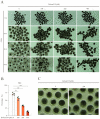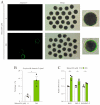TET Family Members Are Integral to Porcine Oocyte Maturation and Parthenogenetic Pre-Implantation Embryogenesis
- PMID: 37569830
- PMCID: PMC10419807
- DOI: 10.3390/ijms241512455
TET Family Members Are Integral to Porcine Oocyte Maturation and Parthenogenetic Pre-Implantation Embryogenesis
Abstract
The ten-eleven translocation (TET) enzyme family, which includes TET1/2/3, participates in active DNA demethylation in the eukaryotic genome; moreover, TET1/2/3 are functionally redundant in mice embryos. However, the combined effect of TET1/2/3 triple-gene knockdown or knockout on the porcine oocytes or embryos is still unclear. In this study, using Bobcat339, a specific small-molecule inhibitor of the TET family, we explored the effects of TET enzymes on oocyte maturation and early embryogenesis in pigs. Our results revealed that Bobcat339 treatment blocked porcine oocyte maturation and triggered early apoptosis. Furthermore, in the Bobcat339-treated oocytes, spindle architecture and chromosome alignment were disrupted, probably due to the huge loss of 5-hydroxymethylcytosine (5hmC)and concurrent increase in 5-methylcytosine (5mC). After Bobcat339 treatment, early parthenogenetic embryos exhibited abnormal 5mC and 5hmC levels, which resulted in compromised cleavage and blastocyst rate. The mRNA levels of EIF1A and DPPA2 (ZGA marker genes) were significantly decreased, which may explain why the embryos were arrested at the 4-cell stage after Bobcat339 treatment. In addition, the mRNA levels of pluripotency-related genes OCT4 and NANOG were declined after Bobcat339 treatment. RNA sequencing analysis revealed differentially expressed genes in Bobcat339-treated embryos at the 4-cell stage, which were significantly enriched in cell proliferation, cell component related to mitochondrion, and cell adhesion molecule binding. Our results indicated that TET proteins are essential for porcine oocyte maturation and early embryogenesis, and they act by mediating 5mC/5hmC levels and gene transcription.
Keywords: 5-hydroxymethylcytosine; 5-methylcytosine; Bobcat339; TET proteins; embryo; oocyte; pig.
Conflict of interest statement
The authors declare no conflict of interest.
Figures








Similar articles
-
TET family regulates the embryonic pluripotency of porcine preimplantation embryos by maintaining the DNA methylation level of NANOG.Epigenetics. 2020 Nov;15(11):1228-1242. doi: 10.1080/15592294.2020.1762392. Epub 2020 May 13. Epigenetics. 2020. PMID: 32397801 Free PMC article.
-
Dynamics of TET family expression in porcine preimplantation embryos is related to zygotic genome activation and required for the maintenance of NANOG.Dev Biol. 2014 Feb 1;386(1):86-95. doi: 10.1016/j.ydbio.2013.11.024. Epub 2013 Dec 4. Dev Biol. 2014. PMID: 24315853
-
DNA demethylation pattern of in-vitro fertilized and cloned porcine pronuclear stage embryos.Clin Chim Acta. 2017 Oct;473:45-50. doi: 10.1016/j.cca.2017.07.025. Epub 2017 Jul 27. Clin Chim Acta. 2017. PMID: 28757075
-
Advances in DNA methylation: 5-hydroxymethylcytosine revisited.Clin Chim Acta. 2011 May 12;412(11-12):831-6. doi: 10.1016/j.cca.2011.02.013. Epub 2011 Feb 12. Clin Chim Acta. 2011. PMID: 21324307 Review.
-
Ten eleven translocation enzymes and 5-hydroxymethylation in mammalian development and cancer.Adv Exp Med Biol. 2013;754:57-79. doi: 10.1007/978-1-4419-9967-2_3. Adv Exp Med Biol. 2013. PMID: 22956496 Review.
Cited by
-
Epigenetics-targeted drugs: current paradigms and future challenges.Signal Transduct Target Ther. 2024 Nov 26;9(1):332. doi: 10.1038/s41392-024-02039-0. Signal Transduct Target Ther. 2024. PMID: 39592582 Free PMC article. Review.
-
Methoxychlor induces oxidative stress and impairs early embryonic development in pigs.Front Cell Dev Biol. 2023 Dec 1;11:1325406. doi: 10.3389/fcell.2023.1325406. eCollection 2023. Front Cell Dev Biol. 2023. PMID: 38107075 Free PMC article.
References
Grants and funding
LinkOut - more resources
Full Text Sources
Research Materials

